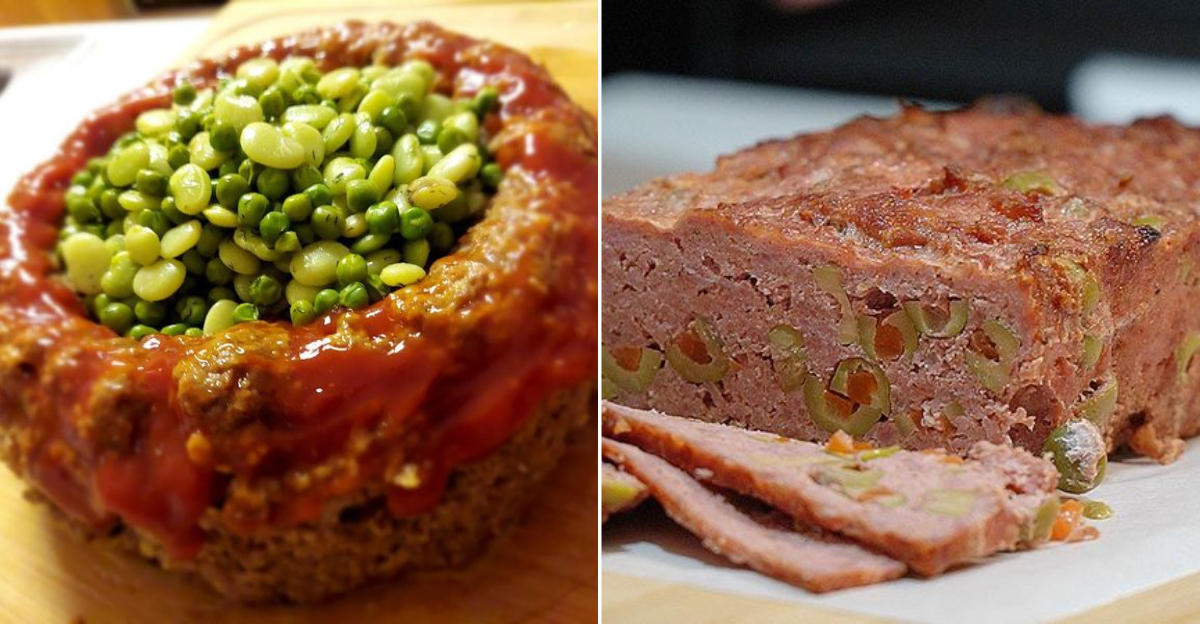12 Common Foods From The ’50s That You Rarely See Today

The 1950s brought us some truly iconic flavors and kitchen staples, but not everything from that era has stood the test of time.
Some classic foods have quietly slipped off our plates and into the realm of nostalgia.
These once-beloved bites tell stories of vintage recipes, quirky trends, and home-cooked comfort that modern menus rarely touch anymore.
Digging into these forgotten foods offers a delicious peek into a tastier time gone by.
1. Jell-O Salad Molds
Wobbling towers of fruity gelatin containing suspended vegetables, mayonnaise, and sometimes even seafood were the centerpiece of fancy ’50s gatherings.
Hostesses competed to create the most elaborate designs, often using special molds shaped like rings, fish, or flowers.
Companies published entire cookbooks dedicated to the art of suspended food in gelatin. The most popular flavors included lime (perfect for savory salads) and strawberry for sweeter concoctions.
2. Aspic Vegetable Terrine
Savory gelatin took dinner parties by storm when meat broths were transformed into translucent edible display cases. Vegetables, hard-boiled eggs, and meat slices would be artfully arranged inside these savory jellies, creating what looked like food trapped in amber.
Cookbooks touted aspics as elegant and economical. The clear gelatin magnified the colors of the vegetables, creating what was considered an artistic food presentation worthy of special occasions.
3. Olive Loaf
Lunch meat got fancy when manufacturers started embedding pimento-stuffed green olives into processed meat mixtures.
The resulting slices featured cross-sections of bright red and green circles against a pale pink background, creating what was considered an artistic meat canvas.
Sandwiches made with olive loaf were staples in lunch boxes and at bridge club gatherings. The salty olive bits provided flavor bursts in otherwise bland processed meats.
4. Spam Casserole
Following wartime rationing, Spam remained a pantry hero throughout the ’50s.
Homemakers transformed the canned meat into family-pleasing casseroles by combining it with noodles, canned vegetables, and cream of mushroom soup.
Cookbooks featured dozens of Spam recipes, from breakfast to dinner. The ultimate Spam casserole usually featured a crushed potato chip topping, adding a satisfying crunch to this budget-friendly meal.
5. Tuna Noodle Casserole
Canned tuna mixed with cooked egg noodles and cream of mushroom soup created the quintessential Wednesday night dinner for middle-class families.
Topped with crushed potato chips or canned fried onions, this dish represented post-war convenience cooking at its finest.
Many home economists promoted this dish as nutritionally complete. The casserole’s popularity soared because it required no fresh ingredients and could be assembled quickly after a day of work.
6. Chipped Beef on Toast
Military personnel brought this dish home from service, introducing families to dried beef in creamy white sauce served over toast.
Affectionately (or not so affectionately) nicknamed “SOS” with the S standing for a word I can’t mention here, this meal stretched minimal ingredients into filling comfort food.
Dried beef came in small glass jars and had to be rinsed to remove excess salt. Despite its humble appearance, this beige-on-beige creation was a protein-packed breakfast that kept families going until dinner.
7. Meatloaf Ring
Ground meat mixed with breadcrumbs and eggs took on architectural ambitions when pressed into ring molds instead of loaf pans.
The center hollow became a serving vessel for mashed potatoes or mixed vegetables, creating an all-in-one dinner presentation.
Cookbooks suggested glazing the meatloaf ring with ketchup or tomato sauce before baking.
This presentation transformed humble ground beef into something worthy of company dinners and Sunday gatherings.
8. Gelatin Fruit Ring
Fruit cocktail from cans found its glamorous purpose when suspended in colorful gelatin rings.
Hostesses would layer different colored gelatins, creating rainbow effects that wowed guests at ladies’ luncheons and holiday gatherings. Special molds with intricate designs were prized kitchen equipment.
The most elaborate versions contained cream cheese layers alternating with fruit-studded gelatin, creating what cookbooks called “salads” despite their dessert-like appearance.
9. Canned Ham with Pineapple
Holiday tables weren’t complete without a glistening canned ham studded with pineapple rings and maraschino cherries.
The sweet glaze, usually made from brown sugar and pineapple juice, created a lacquered finish worthy of magazine covers.
Spiral slicing wasn’t yet common, so carving these hams was a ceremonial task. Leftover ham would appear in sandwiches, casseroles, and breakfast dishes for days following the main event.
10. Cheese Ball Appetizer
No cocktail party was complete without a softball-sized sphere of cheese rolled in chopped nuts.
Made from cream cheese blended with sharp cheddar, Worcestershire sauce, and grated onion, these orbs were the pinnacle of sophisticated snacking.
Cheese balls were served with an array of crackers fanned out around them.
The dramatic presentation moment came when the host made the first cut, revealing the creamy interior beneath the crunchy nut coating.
11. Mock Chicken Salad
Bologna transformed into “chicken” when diced and mixed with celery, mayonnaise, and hard-boiled eggs.
This budget-friendly alternative to real chicken salad was a luncheon staple, often served on lettuce leaves with a side of saltine crackers.
Homemakers appreciated this recipe for using inexpensive lunch meat in a new way.
The addition of sweet pickle relish and a dash of yellow mustard gave this salad its distinctive flavor that fooled absolutely no one into thinking it was actual chicken.
12. Pineapple Cottage Cheese Salad
Canned pineapple chunks stirred into cottage cheese created what was inexplicably categorized as a “salad” despite containing no vegetables whatsoever.
Often served on a lettuce leaf and garnished with a maraschino cherry, this dish appeared at ladies’ luncheons across America.
Health-conscious homemakers embraced this dish for its calcium and protein content.
Some fancy versions included chopped nuts, celery, and a dollop of mayonnaise, further cementing its curious classification as a salad.
